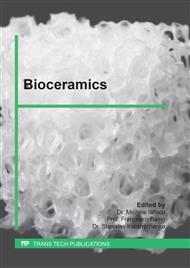p.1815
p.1821
p.1827
p.1833
p.1841
p.1846
p.1853
p.1860
p.1867
Effect of Interface Damage on Loosening Behavior of Acetabular Cup Subjected to Cyclic Loading
Abstract:
This study aims at experimentally revealing the effects of damages/fractures in HAp coating layer of acetabular cups on loosening behavior of the acetabular cups. Aseptic loosening is occurred due to degradation of fixing force of acetabular cups by biological effects or mechanical loading. However, effects of mechanical loading on loosening behaviour have not been observed yet. In order to simulate cyclic loading conditions of gaits, a testing system which can load entire components of joint including acetabular cups and stem parts was designed. Moreover, by applying two positions of AE sensors during fatigue testing, it was possible to observe the damage behavior of HAp coating. AE measurement detected different failure modes of HAp coating, which were locally occurred at an edge part of the acetabular cup due to stress singularity at that region. In the cases of changing fixation angles, even though damages in simulated cancellous bone surrounding acetabular cups were less occurred, extents of rotational displacements were compatible with the one in an original fixation angle.
Info:
Periodical:
Pages:
1841-1845
Citation:
Online since:
December 2018
Authors:
Price:
Сopyright:
© 2018 Trans Tech Publications Ltd. All Rights Reserved
Share:
Citation:



